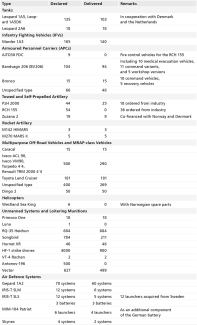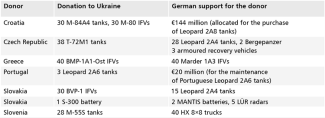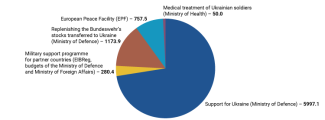German military aid for Ukraine: a new model of support?
On 14 July, during a visit to Washington, German Defence Minister Boris Pistorius (SPD) confirmed that Germany was prepared to acquire two Patriot air defence systems. These would most likely replace the two batteries that Germany plans to deliver to Ukraine. Earlier, General Christian Freuding, head of the Ukraine task force at the Federal Ministry of Defence, announced that by the end of July the first long-range unmanned systems, funded by Germany and produced by Ukraine’s defence industry, would reach the front. Their total is expected to reach the ‘three digits’ range in the coming months. It remains unclear which systems are involved. Media reports suggest that Germany and Ukraine have signed an agreement to finance the production of over 500 Antonov-196 long-range drones. At the end of June, during a visit to Kyiv accompanied by representatives of the German defence industry, Foreign Minister Johann Wadephul (CDU) pledged to increase assistance and expand military cooperation with Ukraine. Under this cooperation, Germany would provide components for the production and maintenance of unmanned strike systems, as well as ballistic and cruise missiles with a range of up to 2,500 km.
In May, amid ongoing Russian attacks and uncertainty regarding US support, Chancellor Friedrich Merz signalled Germany’s readiness to step up military assistance to Kyiv. Given the limited production capacity of the German and European defence industries, Berlin appears to be implementing a new model of support. This is based on financing purchases from the US and manufacturing weapons in Ukraine – the so-called Danish model.
Commentary
- The scope of military support provided by the German government to Ukraine formally makes Germany the second largest donor after the United States. Berlin claims that since 24 February 2022, the total value of this assistance, including funds already ‘secured’ for the coming years, amounts to €38 billion. According to German authorities, by 31 March this year the total value of Germany’s military aid to Ukraine had reached €15 billion. In 2024 alone, Germany allocated €7.1 billion for this purpose, and the draft budget for 2025 is set to earmark a further €8.3 billion (see chart in the Appendix). So far, Berlin has classified as military aid to Ukraine the value of equipment contracted for the German armed forces to replace weapons declared and delivered to Kyiv from Bundeswehr stocks. This also includes commercial orders placed by Ukraine with German defence companies and funded by Germany, even if these orders have not yet been fulfilled (see ‘Germany boosts its funding for military support to Ukraine’). Since April this year, the authorities have ceased publishing detailed data on the types and value of weaponry supplied to Ukraine. This is a consequence of Chancellor Friedrich Merz’s adoption of a policy of ‘strategic ambiguity’, which entails keeping such information confidential (see ‘Friedrich Merz’s foreign policy – opening protocol’).
- Germany’s new model of support, based on purchasing arms from the United States and supplying components for production in Ukraine, may help improve the efficiency of Berlin’s contribution to Kyiv’s war effort. To date, German donations have consisted of three elements: older weapons transferred from Bundeswehr stocks, newly produced equipment ordered from the German defence industry, and modernised systems previously withdrawn from service. The sizeable declared value of German aid does not translate into large volumes of deliveries, mainly due to the high cost of the short and medium -range IRIS-T SL air defence batteries ordered for Ukraine (11 out of 24 declared systems have been delivered) and the long-range Patriot systems (three full batteries and four launchers), along with an undisclosed number of PAC-2 GEM-T and PAC-3 CRI missiles. An additional purchase of two Patriot batteries for Kyiv would imply that Berlin is responsible for providing up to half of Ukraine’s entire Patriot systems. Before its donations to Kyiv, Germany possessed 12 Patriot batteries. In 2024, it decided to acquire eight more, although the delivery timeline remains unclear. Despite media declarations and letters of intent regarding the establishment of German defence industry factories (primarily Rheinmetall) in Ukraine, there is still no evidence that production has begun.
- The German defence industry and armed forces remain technologically and conceptually behind in terms of the production and use of unmanned strike systems. By co-financing their manufacture in Ukraine, Germany will most likely gain access to Ukraine’s extensive experience in this field. Berlin has provided Kyiv with large quantities of unmanned aerial vehicles (UAVs), most of which are relatively small reconnaissance UAVs. By 17 April this year, Germany had delivered approximately 2,600 units, with a further 3,600 pledged. Only since the beginning of this year has Germany begun supplying Ukraine with strike drones. The announced delivery of long-range unmanned strike systems is the result of an agreement reached at the end of May, under which Berlin and Kyiv initiated cooperation to develop a spectrum of long-range strike capabilities. The German defence industry is expected to supply Ukraine with components for the production and maintenance of unmanned systems, as well as ballistic and cruise missiles with a range of up to 2,500 km, to be produced in Ukraine.
APPENDIX
Table 1. German declarations and deliveries of key categories of armaments (as of 17 April)

Table 2. German assistance through ring exchange deliveries

Chart. Planned structure of German financial assistance for Ukraine in 2025 (in million euros)





